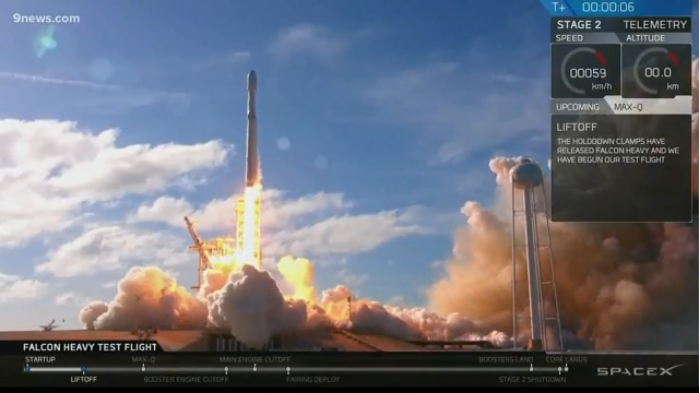CAPE CANAVERAL, Fla. -- SpaceX's Falcon Heavy rocket blasted off Tuesday afternoon from the same Florida launch pad used by NASA nearly 50 years ago to send men to the moon.
With liftoff, Falcon Heavy became the most powerful rocket in use today.
Its three boosters and 27 Merlin engines roared to life at Kennedy Space Center at 3:45 p.m., providing more than 5 million pounds of thrust to get it all off the ground. It was all just in the nick of time before the close of its 4 p.m. launch window.
Not only did the rocket lift SpaceX CEO Elon Musk's red Tesla Roadster into orbit -- with a dummy "Starman" at the wheel -- two of the three boosters flew back and landed upright at Cape Canaveral Air Force Station.
“Today was a pretty good success for SpaceX, but I'd say for the whole aerospace industry here in the United States,” said Phil Larson, Assistant Dean of CU Boulder’s College of Engineering and Applied Science.
Larson worked for SpaceX for two years on its communications team. He says the launch paved the way for what the future of rocket science could look like.
“It's unleashing this whole new era of space exploration. Sort of a new space race,” he said. “Reusability of rockets has always been the Holy Grail. You know, aircraft-like operations but for rockets: launch, land, and take off again, and just refuel it.”
Traditionally rockets of past have been used once and then discarded to make way for new boosters. Two of Falcon Heavy's boosters were used on previous missions, and after Tuesday's launch two of three safely returned right-side up to earth.
The launch was also the largest by a privately-funded space program, meaning taxpayers money was not involved.
The 15-story boosters landed at the same time, side by side, about eight minutes after liftoff with incredible pinpoint accuracy.
Thousands of people watching along the Space Coast were greeted with few sonic booms as they reached the ground.
There was no immediate word on whether the third, center booster managed to touch down on a floating platform 300 miles offshore in the Atlantic Ocean.
The highly-anticipated launch is merely a test in many ways. SpaceX engineers expect the next stage to happen some six hours after launch with an engine firing to send the red Tesla into an orbit as far out as Mars.
Musk has previously said he hopes to send people to colonize the Red Planet with a rocket even larger than Falcon Heavy called the "BFR," or Big Falcon Rocket.
-
Our sister-station WTSP in Tampa, Florida, contributed to this report.


